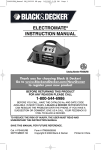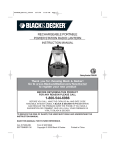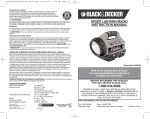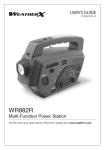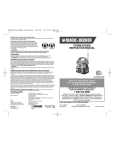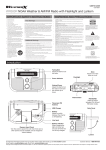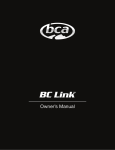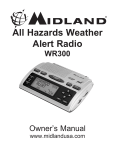Download Black & Decker VEC1029FPOB User`s manual
Transcript
VEC1029FPOB_ManualEN_101606 10/16/06 5:17 PM Page i VEC1029POB VEC1029FPOB Rechargeable Power Center AC/DC Portable Power Supply with AM/FM and NOAA Weather Alert Radio USER’S MANUAL & WARRANTY INFORMATION IMPORTANT SAFETY INFORMATION, SAVE THESE INSTRUCTIONS TO REDUCE THE RISK OF INJURY, USER MUST READ AND UNDERSTAND THIS INSTRUCTIONAL MANUAL. THIS MANUAL CONTAINS IMPORTANT INFORMATION REGARDING THE OPERATION AND WARRANTY OF THIS PRODUCT. PLEASE RETAIN FOR FUTURE REFERENCE. 4140 S.W. 30th Ave., Ft. Lauderdale, FL 33312 Toll Free: (800) 544-6986 VEC1029FPOB_ManualEN_101606 10/16/06 5:17 PM Page 1 IMPORTANT SAFETY INSTRUCTIONS WARNINGS TO REDUCE THE RISK OF FIRE, ELECTRIC SHOCK, EXPLOSION OR INJURY: • This equipment employs components that tend to produce arcs or sparks. DO NOT install in compartments containing batteries or flammable materials. • Use this unit in properly ventilated areas ONLY. Do not block ventilation slots. • DO NOT use the inverter near flammable materials or in locations that may accumulate flammable fumes or gases. • Do not open — there are no user-serviceable parts inside. • Do not insert foreign objects into the outlets. • Do not expose the unit to flammables, water, rain or snow. • This inverter has not been tested for use with medical devices. CAUTIONS • • • • • ALWAYS turn OFF the inverter by disconnecting it from the DC accessory outlet when not in use. NEVER IMMERSE THE UNIT IN WATER. DO NOT expose to extreme heat or flames. DO NOT replace the 12 Volt DC Adapter fuse with one of a higher amperage rating. Although this unit contains a non-spillable battery, it is recommended that the unit be kept upright during storage, use and recharging. To avoid possible damage that may shorten the unit’s working life, protect it from direct sunlight, direct heat and/or moisture. • Check unit periodically for wear and tear. Take to a qualified technician for replacement of worn or defective parts immediately. EXTENSION CORD SAFETY 1. To reduce risk of damage to electric plug and cord, pull by plug rather than cord when disconnecting from the 120 Volt AC Charger. 2. Use of an improper extension cord could result in a risk of fire and electric shock, and will void warranty. When choosing an extension cord to use with this unit, make sure it is properly wired and in good electrical condition. 3. Do not attempt to charge the unit if the 120 Volt AC Charger plug is damaged — return the unit to manufacturer for repair. THIS UNIT IS NOT A TOY AND SHOULD ONLY BE OPERATED BY ADULTS. KEEP AWAY FROM CHILDREN! WEATHER RADIO SAFETY INSTRUCTIONS WARNING: This product should not be the only source of information for all-hazard, watches and warnings. If severe weather is imminent; do not wait to receive the weather alert warning, take precautionary measures to protect yourself. WARNING: The Weather Radio in this unit is designed to receive NOAA weather and other emergency alerts as listed on page 10 of this manual and communicate these alerts to you. You may not receive or clearly hear these alerts under any of, but not limited to, the following circumstances: • Improper setup (Unit not in Alert Mode, or turned on); make sure that the unit is turned on and the Alert LED indicator is lit, (see page 9 for Weather Radio instruction). • Volume is too low; adjust the volume to an audible level using the Volume Control Knob. • Loss of AC power and/or the internal batteries are dead. Recharge the unit using the DC charging method on page 6 or using the AC charging method on page 6 following return of AC power. Be sure to occasionally place the unit back on charge to maximize your runtime in the event of AC power failure. • Lost or poor reception which can be attributed to any of the following: a) Improper antenna setup. To ensure you get the best available reception extend the built-in antenna and adjust its direction to provide maximum reception. b) Improper tuner setup. To ensure you are always tuned in to receive the NOAA alerts check the National Weather Service website @ http://www.nws.noaa.gov/nwr/nwrbro.htm for the signal frequency in your area. If you are on the correct frequency and fail to get a signal, check that you have power and/or try placing the radio close to a window. 1 VEC1029FPOB_ManualEN_101606 10/16/06 5:17 PM Page 2 c) Your location is out of range from a weather radio transmitter; the broadcast range from the weather radio transmitter is approximately 40 miles. The effective range depends on such things as terrain and quality of the receiver and indoor/outdoor antenna. Log onto http://www.nws.noaa.gov/nwr/nwrbro.htm to see which frequency best serves your area. d) Metal structure; to improve the radio’s ability to receive NOAA broadcast; do not place the unit near any large obstructions or metal surfaces such as refrigerators, metal cabinets, etc. In metal structures, such as mobile homes, reception is difficult because the metal structure impedes the transmission of monitor waves, in this case, place the radio close to a window to improve reception. e) Radio frequency interference; some electronics may cause radio frequency interference such as twoway radios, remote control cars, etc. Place the unit as far away as possible from these devices or avoid the usage of devices that cause radio frequency interference while the unit is in alert mode. • If there is excessive background noise while monitoring alerts; or when the alert comes on, adjust the volume using the Volume Control Knob or relocate the unit to a better location where you can hear the weather broadcast without risk of interference from background noise. • If you are out of audible range of or far away from the unit; or if there is an obstruction between you and the radio, be sure to check the unit for warnings periodically or remain close enough (within hearing range) to clearly hear and understand the alerts. WARNING: To ensure to continuously monitor alerts from NOAA while the unit is in alert mode, the unit should be checked periodically to confirm its functionality and for loss of reception; also check for loss of reception after moving the unit to a different location. • Test Warnings from NOAA; all National Weather Services periodically transmit test signals. Some stations broadcast a test signal every week on Wednesday between 11 AM and 1 PM, while others test more often, the NWS may also broadcast System demonstrations. You can find out when your local NWS broadcasts test signals by calling the NOAA National Weather Service Forecast Office (listed under “Weather” in the Federal Government section of the telephone book.) During the weekly test signal, the local NWS will give a list of counties covered by their transmitter. • Check unit periodically for wear and tear. Take to a qualified technician for replacement of worn or defective parts immediately. • Read This Instruction Manual Before Using This Unit. Read This User’s Manual Before Using This Unit. SAVE THESE INSTRUCTIONS This device complies with part 15 of the FCC rules. Operation is subject to the following two conditions: (1) this device may not cause harmful interference, and (2) this device must accept any interference received, including interference that may cause undesired operation. This equipment has been tested and found to comply with the limits for a Class B digital device, pursuant to part 15 of the FCC Rules. These limits are designed to provide reasonable protection against harmful interference in a residential installation. This equipment generates, uses and can radiate radio frequency energy and, if not installed and used in accordance with the instructions, may cause harmful interference to radio communications. However, there is no guarantee that interference will not occur in a particular installation. If equipment does cause harmful interference to radio or television reception, which can be determined by turning the equipment off and on, the user is encouraged to try to correct the interference by one or more of the following measures: • Reorient or relocate the receiving antenna. • Increase the separation between equipment and receiver. • Connect the equipment into an outlet on a circuit different from that to which the receiver is connected. • Consult the dealer or an experienced radio/TV technician for help. 2 VEC1029FPOB_ManualEN_101606 10/16/06 5:17 PM Page 3 TABLE OF CONTENTS Introduction . . . . . . . . . . . . . . . . . . . . . . . . . . . . . . . . . . . . . . . . . . Features . . . . . . . . . . . . . . . . . . . . . . . . . . . . . . . . . . . . . . . . . . . . AC and DC Charging/Recharging . . . . . . . . . . . . . . . . . . . . . . . . . . Viewing Battery Charge Status . . . . . . . . . . . . . . . . . . . . . . . . . . . 120 Volt AC Charging using a Common Household Extension Cord (not included) . . . . . . . . . . . . . . . . . . . . . . . . . . . . . . . . . . . . . . 12 Volt DC Charging . . . . . . . . . . . . . . . . . . . . . . . . . . . . . . . . . Using the 12 Volt DC Portable Power Supply . . . . . . . . . . . . . . . . . . . Using the 120 Volt AC Power Supply . . . . . . . . . . . . . . . . . . . . . . . . AC Power Supply Controls, Indicators and Operation . . . . . . . . . . Using the USB Charging Port . . . . . . . . . . . . . . . . . . . . . . . . . . . . . . Using the Emergency Area Light . . . . . . . . . . . . . . . . . . . . . . . . . . . . Using the Clock/Alarm Clock . . . . . . . . . . . . . . . . . . . . . . . . . . . . . Programming the Clock and Alarm Clock . . . . . . . . . . . . . . . . . . . Using the Radio . . . . . . . . . . . . . . . . . . . . . . . . . . . . . . . . . . . . . . . Using the Sleep Feature . . . . . . . . . . . . . . . . . . . . . . . . . . . . . . . Programming Stations Into Memory . . . . . . . . . . . . . . . . . . . . . . . Using the Weather Radio Alert Feature . . . . . . . . . . . . . . . . . . . . . Using the Detachable Hand-Crank LED Flashlight . . . . . . . . . . . . . . . . Care and Maintenance . . . . . . . . . . . . . . . . . . . . . . . . . . . . . . . . . . Specifications . . . . . . . . . . . . . . . . . . . . . . . . . . . . . . . . . . . . . . . . . . . . . . . . . . . . . . . . . . . . . . . . . . . . . . . . . . . . . 1 1 3 3 . . . . . . . . . . . . . . . . . . . . . . . . . . . . . . . . . . . . . . . . . . . . . . . . . . . . . . . . . . . . . . . . . . . . . . . . . . . . . . . . . . . . . . . . . . . . . . . . . . . . . . . . . . . . . . . . . . . . . . . . . . . . . . . . . . . . . . . . . . . . . . . . 4 4 4 5 5 5 6 6 6 7 7 7 7 8 9 9 INTRODUCTION Thank you for purchasing the VEC1029FPOB Rechargeable Power Center. Please read this guide carefully before use to ensure optimum performance and avoid damage to the unit. FEATURES • Built-in 400 watt inverter • Two 120 Volt AC Outlets to power and recharge 110/120 volt AC appliances • 12 Volt DC Charging Port to power and recharge cell phones and 12 volt DC appliances • USB Charging Port to power and recharge USB personal electronics • Digital AM/FM and NOAA Weather Alert Radio • Built-in monophonic speaker • Earphone Jack for private listening • Built-in powerful LED Area Light for nighttime use • Detachable Hand-Crank LED Flashlight for nighttime roadside repairs and use in remote locations without utility power • Battery charge level indicators • Requires no maintenance (other than recharging) for optimum operation • Battery Status LED Indicator displays battery charge level while charging, or whenever Battery Status Pushbutton is pressed 3 VEC1029FPOB_ManualEN_101606 10/16/06 5:17 PM Page 4 • UL listed, built-in 120 volt AC charger that works with a standard household extension cord (not included) • 12 Volt DC Charging/Power Adapter with built-in storage compartment included • Rechargeable, non-spillable, heavy-duty, sealed lead acid battery • Molded high-impact case is tough and durable Protective Features • Automatic Overload — Built-in protection against overload — in the event the AC outlet draws more than 400 watts, power to the unit’s outlet will automatically shut off. • Ground Fault Circuit Interrupter (GFCI) — The GFCI protects the unit and the user by sensing imbalances in a circuit caused by current leakage to the ground and shuts down the unit’s AC outlet to prevent electrical shock. • Overheating — Unit automatically shuts down if it exceeds a safe temperature. • Low Battery — If the battery power level is too low, the AC Power Supply shuts down automatically. Front View RUBBER HANDLE DC POWER SUPPLY PORT UNIT FRONT PANEL (SEE DETAILED VIEW ON PAGE 5) AM/FM/ WEATHER ALERT RADIO PANEL (SEE DETAILED VIEW ON PAGE 8) AC POWER SUPPLY PANEL (SEE DETAILED VIEW ON PAGE 7) Back View BUILT-IN TELESCOPING ANTENNA BUILT-IN AC CHARGER MONOPHONIC RADIO SPEAKER DC CHARGING/POWER ADAPTER STORAGE COMPARTMENT 4 VEC1029FPOB_ManualEN_101606 10/16/06 5:17 PM Page 5 Unit Front Panel USB POWER LED BATTERY CHARGE LEVEL PUSHBUTTON BATTERY CHARGE LEVEL INDICATORS USB CHARGING PORT USB CHARGING PORT ON/OFF SWITCH AREA LIGHT AREA LIGHT ON/OFF SWITCH AC AND DC CHARGING/RECHARGING Use a common household AC extension cord for charging (cord not supplied). For maximum battery life, we recommend the unit be kept fully charged at all times. If the battery is allowed to remain in a discharged state, battery life will be shortened. • MAKE SURE ALL SWITCHES ARE TURNED OFF DURING RECHARGING. • FULLY CHARGE THE UNIT USING THE 120 VOLT AC CHARGING METHOD BEFORE FIRST USE. • Recharge the unit fully after each use. • Recharge the unit every two months when it has not been used regularly. Notes: Recharging the battery after each use prolongs battery life; frequent discharges between recharges reduces battery life. The Power Center also comes with a 12 Volt DC charging adapter for recharging the unit from a 12 volt DC accessory outlet in a vehicle. If unit is fully discharged, it is recommended that the vehicle being used for recharging be left running while the unit is charged via the 12 volt DC method. Viewing Battery Charge Status Press the Battery Charge Level pushbutton to display battery status. The Battery Charge Level Indicator LEDs will light. LEDs (from right to left): • Red LED indicates a low battery charge. • Two Red LEDs indicate a medium level or partially charged battery. • Three Red and one Green LEDs indicates a full or high battery charge level. 5 VEC1029FPOB_ManualEN_101606 10/16/06 5:17 PM Page 6 120 Volt AC Charging using a Common Household Extension Cord (not included) 1. Lift the AC Charger cover located on the back of the Power Center and connect a standard household extension cord to the unit. Plug the other end of the cord into a standard North American 120 volt AC wall outlet. 2. Charge until three Red and one Green LEDs light. 3. Once fully charged, disconnect the extension cord. Note: The unit cannot be overcharged using this method. 12 Volt DC Charging The 12 Volt DC recharging method will NOT recharge the unit as effectively as recharging from 120 volt AC. The 12 volt DC recharging procedure is recommended only when it is necessary, since frequent use of the 12 volt DC recharging procedure may shorten the battery system’s life. 1. Insert the gold-tipped DC Charging Adapter end plug into the vehicle’s 12 volt DC accessory outlet. 2. Insert the silver-tipped end plug into the 12 Volt DC Outlet on the front panel of the unit. 3. To check the charge status of the battery during DC charging, disconnect the DC adapter from the accessory outlet and push the Battery Charge Level pushbutton. Observe the battery charge indicator. 4. When charging is complete, remove the power cord. WARNING Do not recharge for more than 5 to 6 hours maximum using the 12 volt DC method. USING THE 12 VOLT DC PORTABLE POWER SUPPLY 1. Flip open the 12 Volt DC Outlet cover on the upper right side of the unit. 2. Insert the 12 volt DC plug from the appliance (cell phone charger, etc.) into the outlet. 3. Turn on the appliance and operate normally. Make sure to disconnect all appliances from the 12 Volt DC Outlet when the unit is being recharged or stored. CAUTION DO NOT USE UNIT TO POWER APPLIANCES THAT DRAW MORE THAN 5 AMPS DC. 6 VEC1029FPOB_ManualEN_101606 10/16/06 5:17 PM Page 7 USING THE 120 VOLT AC POWER SUPPLY The Power Center comes with: 1. AC On/Off Switch — Press switch to turn the AC Power AC POWER Supply on and off. SUPPLY PANEL 2. Dual 120 Volt AC Power Outlets. 3. AC Power Supply “ON” Status Indicator (green LED) — lights when AC outlet is turned on; green LED flashes on and off when faulted. 4. AC Power Ground Fault Circuit Interrupt (GFCI) — two three-prong outlets for 110/120 volt AC appliances which shut down inverter if leakage or ground fault current is detected. 5. Internal protective circuits including: • Overload and over-temperature shutdown (activated if AC output exceeds 400 watts or the unit overheats) • AC short-circuit shutdown • Low voltage shutdown • A new cooling technology that more efficiently cools the power transistors, dramatically increasing reliability and product life. AC Power Supply Controls, Indicators and Operation The illustration above details the AC Power Supply Panel. The ON/OFF switch turns the AC power circuitry ON and OFF. It can also be used to reset AC power after shutdown due to overvoltage, overload or over-temperature condition. The “ON” status indicator lights when AC power supply is available. 1. Turn power switch to ON (the power indicator lights). 2. Plug in appliance and operate as usual. Make sure the 120 Volt AC Power Supply switch is in the OFF position when the unit is being recharged or stored. Note: The AC power supply shuts down automatically when the battery voltage level is too low. If the green LED flashes, a faulty condition such as an overload, overheating or short circuiting has occurred. Turn the AC Power Supply OFF and unplug the appliance. Wait a few minutes, then turn power back ON. USING THE USB CHARGING PORT Both the USB Charging Port and its ON/OFF Pushbutton are located on the unit’s Front Panel (see page 5). 1. Press the USB Charging Port ON/OFF Pushbutton to turn the USB Port ON. The red USB Power LED will light. 2. Lift the rubber cover to access the USB Charging Port (on the Front Panel). 3. Plug the USB-powered device into the USB Power Port and operate normally. 4. Press the ON/OFF Pushbutton again to turn the USB Charging Port OFF when you are finished. Notes: This unit’s USB Charging Port does NOT support data communication. It only provides 5 volts/500mA DC maximum power to an external USB-powered device. To conserve battery power, ALWAYS turn the USB Charging Port OFF when not in use. 7 VEC1029FPOB_ManualEN_101606 10/16/06 5:17 PM Page 8 USING THE EMERGENCY AREA LIGHT The Area Light is controlled by an ON/OFF pushbutton (both are located on the Unit’s Front Panel). Make sure the Area Light is turned OFF when the unit is being recharged or stored. USING THE CLOCK/ALARM CLOCK Programming the Clock and Alarm Clock By default, the Digital Display shows the time (hours: minutes (AM/PM), with the seconds displayed in the upper right corner). Note that the back light will activate automatically whenever any button is pressed. This unit allows the user to program in two separate alarm times. Each Alarm Clock setting can be programmed to respond at the programmed time with either the Alarm sound or automatically turn the Radio ON (to the last station tuned in). Before using the Alarm Clock feature, you must program in the time. Refer to the above enlargement of the Radio Panel to locate referenced buttons and controls. Make sure the Radio ON/OFF Pushbutton is in the OFF position, as this puts the unit in Clock mode (where you can program the clock and alarm time and settings). Setting Up the Clock 1. Press the MEM/CLOCK Pushbutton once. The numbers on the Digital Display will blink. 2. Press the HOUR Pushbutton until the correct hour displays (cycling through from AM to PM). 3. Press the MIN Pushbutton until the correct minute displays. 4. Press the MEM/CLOCK Pushbutton to save. The unit automatically goes to alarm set-up. Simply press the MEM/CLOCK Pushbutton twice to exit and save all changes without setting up an alarm time. Setting Up the Alarm Clock 5. To set the Alarm Clock, press the MEM/CLOCK Pushbutton until the numbers on the Digital Display blink and “AL1” (Alarm setting 1) appears at the bottom of the display. 6. Program in the time for the first alarm as outlined in steps 2 through 3 above. 7. Press the MEM/CLOCK Pushbutton to save the first alarm setting. The unit automatically goes to second alarm set-up. The numbers on the Digital Display will blink and “AL2” (Alarm setting 2) will appear at the bottom of the display. 8. Program in the time for the second alarm as outlined in steps 2 through 3 above. 9. When finished, press the MEM/CLOCK Pushbutton once more to save all settings. Alarm Clock Settings Pressing the “AL1 SET” cycles through the Alarm/Radio/OFF setting for the first alarm. Pressing the “AL2 SET” cycles through the Alarm/Radio/OFF setting for the second alarm. 8 VEC1029FPOB_ManualEN_101606 10/16/06 5:17 PM Page 9 USING THE RADIO Refer to the enlargement of the Radio Panel on page 8 to locate referenced buttons and controls. By default, the Digital Display shows the time. Pressing the Radio ON/OFF Pushbutton ( ) toggles between turning the Radio ON and OFF. When it is ON, the Digital Display shows the currently selected frequency and station. Note that the back light will activate automatically whenever any button is pressed. Press the BAND/ALERT Pushbutton to cycle through to the desired frequency (AM, FM or WX [Weather]). Use the TUNING Pushbuttons (+ or –) to cycle up or down to the desired station. Note: When WX (Weather Band) is selected, the display will show “CH 01” through “CH 07” indicating which of the seven NOAA weather stations is currently selected. Using the Sleep Feature Press the Radio ON/OFF Pushbutton to turn the Radio ON. Press the SLEEP Pushbutton. “Sleep” will blink in the upper center and “90” in the right corner of the Digital Display. Press the SLEEP Pushbutton repeatedly until the desired number of minutes shows. Press and hold the SLEEP Pushbutton to show the rest time. To cancel the Sleep feature, press the SLEEP Pushbutton again. Programming Stations Into Memory Up to 10 stations can be programmed into memory. • Press the Radio ON/OFF Pushbutton to turn the Radio ON. • Press the BAND/ALERT Pushbutton to cycle through to the desired frequency (AM or FM). • Use the TUNING Pushbuttons (+ or –) to cycle up or down to the desired station. • Press and hold the MEM/CLOCK Pushbutton until a blinking “M” appears on the Digital Display. • Press the TUNING Pushbuttons (+ or –) to select the desired memory station number. • Press the MEM/CLOCK Pushbutton to save the setting. • Repeat this process (up to 9 times). Stations will be accessed in the order they were programmed in. To Access User-Programmed Stations: • Press the Radio ON/OFF Pushbutton to turn the Radio ON. • Press the BAND/ALERT Pushbutton to cycle through to the desired frequency (AM or FM). • Press the MEM/CLOCK Pushbutton to cycle through all programmed stations until desired memory number appears. Using the Weather Radio Alert Feature To use the Weather Alert feature, you must first select the WX (Weather) frequency and NOAA weather station. Press the BAND/ALERT Pushbutton to turn the Alert feature ON while the radio is OFF. Press and hold the BAND/ALERT pushbutton to turn the Alert feature ON while the radio is ON. “ALERT” will appear on the Digital Display. 9 VEC1029FPOB_ManualEN_101606 10/16/06 5:17 PM Page 10 You may turn the Radio back ON and listen to the weather station. When a Weather Alert is received, the unit will sound an Alert. When a weather alert is received while the Radio is in the OFF position, an Alert will sound and the Radio will turn ON automatically. To turn OFF the Alert feature, press the BAND/ALERT Pushbutton once more while the radio is OFF. Press and hold the BAND/ALERT Pushbutton while the radio is ON. “ALERT” will disappear from the Digital Display. Notes: You MUST be tuned to the desired weather radio station in order to use the Alert feature. In Alert Mode, the default is the last weather station that was tuned in. The unit default is “CH 01.” It is recommended that you select the weather station with the best reception before putting the unit in Alert mode. When the battery level is LOW, the battery icon and back light will blink and the radio will be turned OFF after 10 minutes automatically. NOAA WEATHER RADIO (NWR) ALL HAZARDS NWR is an all-hazards public warning system, broadcasting forecast, warning and emergency information 24 hours a day directly to the public. 7 NWR Broadcast Frequencies include: 162.400MHz, 162.425 MHz, 162.450 MHz, 162.475 MHz, 162.500 MHz, 162.525 MHz, 162.550MHz Broadcast range from the weather radio transmitter is approximately 40 miles. The effective range depends on such things as terrain and quality of the receiver and indoor/outdoor antenna. Log onto http://www.nws.noaa.gov/nwr/nwrbro.htm to see which frequency best serves your area. “All-Hazard” messages are: • Weather emergencies • Chemical & biological hazard • Tornados • Oil spill • Hurricanes • Nuclear power plant emergencies • Floods • Maritime accidents • Blizzards • Train derailment • Natural emergencies • National emergencies • Earthquakes • Homeland security warnings • Forest fires • Terrorists attacks • Avalanches • Civil emergencies • Technological emergencies • Amber alerts Non-weather emergency messages will be broadcast over NWR when: • (1) public safety is involved • (2) the message comes from an official government source • (3) time is critical The National Response Plan assigns responsibility to NOAA’s National Weather Service (NWS) to broadcast non-weather emergency messages. Non-weather emergency messages will be broadcast over NWR at the request of local and/or state officials who wish to broadcast a message on NWR, the official provides text information about the hazard and the appropriate response directly to the local NWS offices. NWS offices have set up pre-arranged agreements to facilitate and speed the process. 10 VEC1029FPOB_ManualEN_101606 10/16/06 5:17 PM Page 11 NWR and the Emergency Alert System (EAS) use the same digital protocols, and NWR is the primary means for NWS alerts to activate the EAS. The Federal Communications Commission (FCC) amended the EAS rules in 2002 and adopted numerous codes. NWS introduced the new codes on June 30, 2004. Log onto https://www.weather.gov/os/eas_codes.shtml for a complete listing of EAS Event (NWR-SAME) Codes if your receiver is equipped with Digital SAME Technology. USING THE DETACHABLE HAND-CRANK LED FLASHLIGHT The VEC1029POB also comes with a detachable Hand-Crank LED Flashlight. Features include: • 3 long-life, ultra bright beam LED lights • Powered by a flip-up, dynamo hand crank (no need to buy batteries) LED SELECTION PUSHBUTTON 3 LED LIGHTS DYNAMO HAND CRANK (UNDERSIDE OF UNIT) Charge the LED Flashlight by opening (flipping up) the dynamo hand-crank’s handle (located on the underside of the flashlight) and hand cranking in a clockwise direction at a rate of one to two rotations per second (for optimal charging). Approximately one minute of hand cranking will yield up to 30 minutes of runtime at the single LED setting or up to 10 minutes of runtime at the 3-LED setting. The Flashlight’s ON/OFF function and LED settings are controlled by the LED Selection pushbutton on the top of the Flashlight as follows: • Depress the LED Selection Pushbutton for the single LED setting (one LED will light). • Depress the LED Selection Pushbutton a second time for the 3-LED setting. • Depress the LED Selection Pushbutton a third time to switch the LED Flashlight OFF. CARE AND MAINTENANCE Replacement Parts For replacement parts (batteries, fuses, adapters, etc.), contact Customer Service, toll-free, at (800) 544-6986. CAUTION If the cord, wires, or cables become damaged, return the entire unit to Power On Board immediately for service/repair. 11 VEC1029FPOB_ManualEN_101606 10/16/06 5:17 PM Page 12 Fuse Replacement (12 Volt DC Charging/Power Adapter) 1. Remove plug from accessory outlet. Remove the gold cap by turning counterclockwise and lifting off. 2. Remove center pin and spring. Remove fuse. 3. Replace fuse with same type and size fuse (8 amp). 4. Replace center pin and spring inside plug. 5. Replace gold cap by turning clockwise. Battery Replacement/Disposal It is recommended that the unit be returned to Customer Service for battery replacement. This unit contains a maintenance-free, non-spillable, sealed lead-acid battery. This battery is fully recyclable and should be accepted at any location that accepts common automotive batteries. Examples of places that accept these batteries are: county or municipal recycling drop-off centers, scrap metal dealers and retailers who sell automotive replacement lead acid batteries. WARNINGS Do not dispose of the battery in fire, as this may result in an explosion. Before disposing of the battery, protect exposed terminals with heavy-duty electrical tape to prevent shorting (shorting can result in injury or fire). Do not expose battery to fire or intense heat, as it may explode. SPECIFICATIONS 12 Volt DC Specifications Battery: Internal Battery Type: Internal Battery Capacity: Area Light : Accessory Outlet Protection: DC Charging Adapter: 12 volt DC rechargeable, maintenance-free Sealed, AGM lead-acid 12 volt, 19Ah/20 hour rate Light Emitting Diode (LED) Self-resetting overload protection 12 volt DC AC Power Specifications Output Power: Output Voltage: Output Frequency: Output Waveform: Overheat Protection: Overload Protection: Output Short Circuit Protection: 400 watts 120 VAC RMS 60 Hz ±4 Hz Modified sine wave Yes Yes Yes 12 VEC1029FPOB_ManualEN_101606 10/16/06 5:17 PM 13 Page 13 VEC1029FPOB_ManualEN_101606 10/16/06 5:17 PM 14 Page 14 VEC1029FPOB_ManualEN_101606 10/16/06 5:17 PM Page 15 TWO YEAR LIMITED WARRANTY PROGRAM This limited warranty program is the only one that applies to this product, and it sets forth all the responsibilities of Power On Board, regarding this product. There is no other warranty, other than those described herein. Any implied warranty of merchantability or fitness for a particular purpose on this product is limited in duration to the duration of this warranty. This Power On Board product is warranted, to the original purchaser only, to be free of defects in materials and workmanship for two years from the date of purchase without additional charge. The warranty does not extend to subsequent purchasers or users. Manufacturer will not be responsible for any amount of damage in excess of the retail purchase price of the product under any circumstances. Incidental and consequential damages are specifically excluded from coverage under this warranty. This product is not intended for commercial use. This warranty does not apply to damage to units from misuse or incorrect installation/connection. Misuse includes wiring or connecting to improper polarity power sources. RETURN/REPAIR POLICY: Defective products may be returned to manufacturer. Any defective product that is returned to manufacturer within 30 days of the date of purchase will be replaced free of charge. If such a product is returned more than 30 days but less than two years from the purchase date, manufacturer will repair the unit or, at its option, replace it, free of charge. If the unit is repaired, new or reconditioned replacement parts may be used, at manufacturer’s option. A unit may be replaced with a new or reconditioned unit of the same or comparable design. The repaired or replaced unit will then be warranted under the terms of the remainder of the warranty period. The customer is responsible for the shipping charges on all returned items. During the warranty period, manufacturer will be responsible for the return shipping charges to the customer in the United States. LIMITATIONS: This warranty does not cover accessories, such as charging adapters, bulbs, fuses and batteries, damage or defects resulting from normal wear and tear (including chips, scratches, abrasions, discoloration or fading due to usage or exposure to sunlight), accidents, damage during shipping to our service facility, alterations, unauthorized use or repair, neglect, misuse, abuse, failure to follow instructions for care and maintenance, fire, flood and Acts of God. If your problem is not covered by this warranty, call our Technical Support Department toll free at (800) 544-6986 for general repair information and charges if applicable. STATE LAW RIGHTS: This warranty gives you specific legal rights. Some states do not allow limitations on how long an implied warranty lasts or the exclusion or limitation of incidental or consequential damages, so the exclusions or limitations stated herein may not apply. This warranty gives the purchaser specific legal rights; other rights, which vary from state to state, may apply. TO REQUEST WARRANTY SERVICE FOR THIS PRODUCT: Contact Technical Support by telephone, fax or mail (see below). We suggest that you keep the original packaging in case you need to ship the unit. When returning a product, include your name, address, phone number, dated sales receipt (or copy) and a description of the reason for return and product serial number. After repairing or replacing the unit, we will make every effort to return it to you within four weeks. WARRANTY ACTIVATION: Please complete Warranty Activation Card and mail to Power On Board. Enter “VEC1029FPOB” as Model and “Rechargeable Power Center AC/DC Portable Power Supply” as Product Type. All Power On Board products must be registered within 30 days of purchase to activate this warranty. Mail the completed registration form, along with a copy of the original sales receipt, to: BLACK & DECKER 4409 W. Wanda, McAllen, TX 78503 TOLL FREE: 800-544-6986 • Fax: 956-630-0492. WARRANTY IS NON-TRANSFERABLE. RD101606 © 2006 VECTOR PRODUCTS, INC. MADE IN CHINA
















